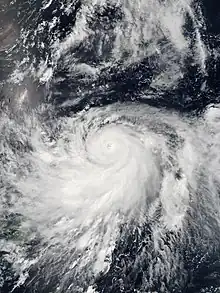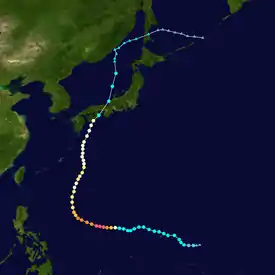Typhoon Halong (2014)
Typhoon Halong, known in the Philippines as Super Typhoon Jose, was an intense Typhoon in the Western Pacific basin in August 2014. It was the twelfth named storm and the fifth typhoon of the 2014 Pacific typhoon season. The storm reached its maximum intensity as a Category 5 super typhoon, making it the fifth strongest storm of the season, surpassed by Genevieve, Vongfong, Nuri and Hagupit.
 Typhoon Halong at peak intensity east of the Philippines on August 3 | |
| Meteorological history | |
|---|---|
| Formed | July 27, 2014 |
| Dissipated | August 15, 2014 |
| Violent typhoon | |
| 10-minute sustained (JMA) | |
| Highest winds | 195 km/h (120 mph) |
| Lowest pressure | 915 hPa (mbar); 27.02 inHg |
| Category 5-equivalent super typhoon | |
| 1-minute sustained (SSHWS) | |
| Highest winds | 260 km/h (160 mph) |
| Lowest pressure | 918 hPa (mbar); 27.11 inHg |
| Overall effects | |
| Fatalities | 12 total |
| Damage | $72.8 million (2014 USD) |
| Areas affected | Caroline Islands, Mariana Islands, Philippines, Japan, Russia |
| IBTrACS | |
Part of the 2014 Pacific typhoon season | |
Meteorological history

Tropical storm (39–73 mph, 63–118 km/h)
Category 1 (74–95 mph, 119–153 km/h)
Category 2 (96–110 mph, 154–177 km/h)
Category 3 (111–129 mph, 178–208 km/h)
Category 4 (130–156 mph, 209–251 km/h)
Category 5 (≥157 mph, ≥252 km/h)
Unknown
On July 26, JMA monitored a low-pressure area near Chuuk. The system stalled for a few days and was upgraded into a tropical depression on July 27. Early on July 29, the depression showed signs of intensification and with that, JTWC upgraded it to Tropical Storm 11W. Later that day, JMA upgraded 11W to Tropical Storm Halong.[1] In the same time Halong started developing a small, unclear eye.[2] With this, gale and typhoon force winds were reported over Guam.[3]
Very late on July 30, JMA upgraded Halong to a severe tropical storm. The next day, both agencies upgraded it to a minimal typhoon. In the same time, Halong started its rapid deepening phase.[4] On August 2, Halong's eye developed clearer than before as the system underwent explosive intensification from a category 1 typhoon to a Category 3 in less than 24 hours. Rapid deepening continued and it eventually became a category 5 super typhoon, with pressure dropping from 980 to 925 mbar in 48 hours.[5][6] However, late that day, JMA revised Typhoon Halong's minimum pressure to 920 mbar. On August 4, Halong weakened to a category 4 typhoon, due to it undergoing an eyewall replacement cycle. The next day, Halong weakened to a minimal typhoon, although it was a deep typhoon due to its pressure. In the same day, its convection was steadily weakening.[7]
On August 6, NASA reported that Halong was beginning undergo an eyewall replacement cycle. This made the JTWC upgrade it to a category 2 typhoon again.[8] Its eye continued to undergo the eyewall replacement cycle until August 8. On the same day, Halong weakened to a category 1 typhoon and started to affect mainland Japan.[9] The JTWC downgraded Halong to a tropical storm on August 9, while the JMA followed suit several hours later. Halong made landfall over the southern part of Japan prior to August 10.[10] On August 10, JTWC issued their final bulletin on Halong, as it was leaving the country.[11] The JMA also issued their final advisory on August 11, as it was becoming extratropical. Its remnants dissipated early on August 15 over Siberia, as it was absorbed by a developing extratropical system.[12]
Preparations and impact

Philippines
In Subic, Zambales, 4 rescue boats were ready in case of flash floods. The Subic Public Order and Safety Office had also prepared rescue equipment for possible flooding.[13]
Typhoon Halong was known in the Philippines as Typhoon Jose. On August 4, the NDRRMC warned residents of flood and landslide-prone areas in Luzon, to take precautions as Typhoon Halong would enhance the southwest monsoon.[14] PAGASA also issued a gale warning in Luzon.[15]
On August 7, 2 people were reported missing in Pangasinan, due to the enhanced monsoonal rains from Jose. They were reported dead on the next day. A total of nearly 16,000 people were affected by the enhanced monsoon.[16] NDRRMC said that a total of ₱1.62 million (US$37,000) were from agricultural damages from the same province alone.[17]
Although it did not made landfall in the Philippines, the name Jose was retired from its naming lists as it caused about P1.6 billion (US$36.3 million) in damage. PAGASA chose the name Josie to replace Jose.[18][19]
Japan
The eye of Halong was located east of Daitō Islands on August 7, bringing typhoon-force winds over the islands. Later that day, the storm passed within 40 km (25 mi) over an island. Early on August 9, Halong underwent a deep eyewall replacement cycle, just before landfall over mainland Japan. Later that day, it was reported that a 78-year-old man died in Iwate Prefecture due to heavy flooding.[20] In the early-morning of August 10, Halong made landfall over Shikoku as a minimal typhoon, just before being downgraded as a severe tropical storm by the JMA. About 1.6 million people in Japan had to evacuate during the storm.[21] In total, the storm is responsible for 10 deaths and 96 injuries.[22] Agricultural damage in Okinawa, Kochi and Wakayama were calculated at around ¥3.72 billion (US$36.5 million).[23][24][25]
See also
References
- "Okinawa and Possible Tropical Storm Nakri (Tuesday Update)". Robert Speta. Archived from the original on July 30, 2014. Retrieved July 28, 2014.
- "Typhoon Warnings in Place as Halong Moves over Guam". Robert Speta. Retrieved July 29, 2014.
- "TS Watches in Guam, Tropical Storm Halong (Tuesday Update)". Robert Speta. Archived from the original on July 30, 2014. Retrieved July 29, 2014.
- "Typhoon 201411 (HALONG)".
- "Typhoon 11W (Halong), # 19: Strengthening, tracking even closer to Okinawa". David Ornauer. Retrieved August 2, 2014.
- "Typhoon Halong rapidly intensifies - Update #2 (August 2, 2014)". Force Thirteen. Retrieved August 1, 2014.
- "NASA satellite sees a somewhat lopsided Typhoon Halong". Rob Gutro, NASA. Retrieved August 5, 2014.
- "Typhoon Halong Opens Its Eye Again for NASA". Rob Gutro, NASA. August 6, 2014.
- "NASA's Aqua Satellite Captures Halong's Movements Near Japan". NASA. August 8, 2014.
- "NASA's Terra Satellite Sees Now Tropical Storm Halong Over Japan". NASA. 28 July 2014. Retrieved August 9, 2014.
- "Tropical Storm Halong Moving Away From Japan". NASA. 28 July 2014. Retrieved August 11, 2014.
- "A View of Typhoon Halong from NASA's International Space Station". NASA. August 12, 2014. Retrieved August 12, 2014.
- "Heavy rains over NCR, nearby provinces this Monday". Retrieved August 4, 2014.
- "NDRRMC warns residents vs. flood, landslide as Typhoon Jose enhances monsoon". Joel Locsin. Retrieved August 4, 2014.
- "Monsoon rain over north, Central Luzon as Typhoon Jose continues northwest". Retrieved August 4, 2014.
- "2 dead due to monsoon enhanced by Typhoon Jose". Joel Locsin. Retrieved August 8, 2014.
- "Monsoon enhanced by Typhoon Jose affects 3,995, causes P1.6M damage". Joel Locsin. Retrieved August 7, 2014.
- "Pagasa kills names of killer typhoons". Philippine Daily Inquirer. February 8, 2015. Archived from the original on February 9, 2015. Retrieved February 9, 2015.
- "Philippine Tropical Cyclone Names". Philippine Atmospheric, Geophysical and Astronomical Services Administration. Archived from the original on February 1, 2015. Retrieved February 1, 2015.
- "Typhoon Halong Becomes Deadly 台風 11". Robert Speta. Retrieved August 9, 2014.
- "Japan Orders 1.6 Million to Evacuate as Typhoon Halong Lashes West Coast". NDTV. Reuters. August 10, 2014. Retrieved August 11, 2014.
- "Typhoon Halong leaves up to 10 dead after battering Japan: reports". 11 August 2014. Retrieved August 12, 2014.
- "Damage estimate from Halong nearly ¥250 million". Retrieved August 12, 2014.
- 台風11号の農業被害15.8億円 ショウガや果樹など (in Japanese). 高知新聞. August 13, 2014. Retrieved August 14, 2014.
- 和歌山県の台風11号最終被害額18億8535万円 (in Japanese). 産経ニュース. September 18, 2014. Retrieved September 30, 2014.
External links
- JMA General Information of Typhoon Halong (1411) from Digital Typhoon
- 11W.HALONG from the U.S. Naval Research Laboratory
